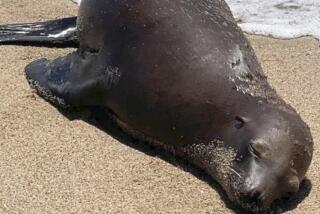CLIPBOARD : HOW TO: CARE FOR INJURED OR ABANDONED WILDLIFE
Even though Orange County is primarily urban, there are still open spaces adjacent to human habitats that support a variety of wildlife. Vacant lots are often home to families of skunks and opossums. Raccoons and squirrels are common in wooded areas and a variety of marine mammals occupy the shoreline. It is not uncommon to encounter these adaptable and resilient neighbors while out on a walk or even in one’s back yard.
The best thing to do is to leave them alone. But if they are injured or abandoned and require immediate protection, there are several things you can do to help until animal control authorities ((714) 935-7480) arrive or the proper treatment facility can be located.
The Pacific Wildlife Project, a nonprofit wildlife treatment center in Laguna Niguel, offers these suggestions:
* Prepare a rescue and transport box. A cardboard box lined with smooth toweling is sufficient for small mammals and birds. (Avoid rough, loopy terry cloth; it gets tangled in claws and could cause injury.) Capture the animal by throwing a large, thick towel over it and scooping it into the box. Cover the box immediately with another towel. Keep the animal warm, dark and quiet. Do not peek into the box. Keep children and pets away.
Arrange for transport by calling city or county animal control authorities immediately. Pacific Wildlife Project ((714) 831-1178) will also transport injured wildlife and advise you over the phone on proper emergency care.
* Baby birds: It is normal for adult birds to leave their young alone in the nest with siblings while they are out hunting for food. Unless you are absolutely sure the babies have been orphaned, the best thing to do is leave them alone. It is not true that birds reject their young when touched by humans, so if the birds have been removed from the nest, simply place them back. If the nest is damaged, put what is left of it inside a strawberry basket lined with facial tissue or dryer lint. Do not use cotton or any kind of stringy cloth. Anchor it back in place with twist ties.
* Hummingbirds require special emergency care. They must have fluid within an hour of rescue. Mix one tablespoon of granulated white table sugar with 1/4 cup warm water until sugar dissolves. When the mixture is cool, offer it in a clean eye dropper held at the tip of the bird’s beak. Jiggle the dropper slightly to encourage the bird to drink (you will see the throat move). Do not squeeze the dropper. Feed at 20-minute intervals until bird is transported to a care center. Hummingbirds must be treated by trained rehabilitators familiar with their dietary needs. Sugar water and commercial hummingbird foods will not sustain life for prolonged periods.
* Sea birds and other water fowl sometimes get tangled in fishing lines and get fish hooks caught in their mouths. Capture the bird using the procedures outlined above. Do not attempt to untangle the bird yourself. If it struggles, it could injure itself. Most importantly, do not cut the line attached to a fish hook embedded in the bird’s mouth. This makes the hook more difficult to remove. Birds may strike defensively, so use caution when handling them.
* Weanling and juvenile mammals frequently venture out around the den and may seem tame, but it is best to leave them alone. Most likely they will return home. However, they occasionally get lost while following parents on foraging expeditions. Give the adult time to locate its lost young before attempting a rescue.
* Beached or injured seals, sea lions, dolphins and whales: Keep humans and pets at least 20 feet away. Do not try to scare the animal back into the water. Do not touch the animal or try to splash water on it. Do not feed it.
Tell the lifeguard or contact Friends of Sea Lions ((714) 494-3050). This organization will provide emergency care for all marine animals, but the National Marine Fisheries Service is primarily responsible for whales and dolphins. Contact Joe Cordero at (213) 514-6666.
A * word of caution: Drought conditions are forcing previously reclusive predators such as cougars and coyotes to hunt for food in areas they usually shy away from. Although the incidents are rare, an increasing number are showing up in areas occupied by humans. Do not approach one of these animals or their young. Call animal control authorities immediately.
Source: Pacific Wildlife Project, Friends of Sea Lions, Orange County Animal Control.


